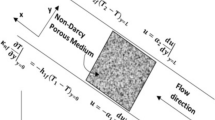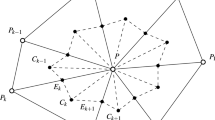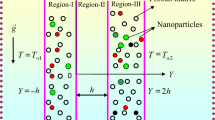Abstract
The paper presents the mixed convection heat transfer and entropy generation of a nanofluid containing carbon nanotubes, flowing in a 3D rectangular channel, subjected to opposed buoyant forces. The governing equations, including the continuity, momentum and energy equations, have been numerically solved using the finite volume technique. The results, including the contours of the axial velocity and temperature, have been presented for different values of the opposed buoyancy parameter (− 300 < Ω < − 100). The outcomes show that with an increase in the opposed buoyancy parameter, the nanofluid velocity near the channel wall drastically reduces and, therefore, causes a reduction in the Nusselt number. In addition, due to the occurrence of backflow phenomenon, an increment of the opposed buoyancy parameter enhances the total entropy generation along the channel. In brief, the friction-induced entropy generation is negligible compared with the entropy generation due to heat transfer. Finally, by increasing the value of the opposed buoyancy parameter, the ratio of the heat transfer rate to irreversibility decreases within the system.
Graphical abstract


















Similar content being viewed by others
Abbreviations
- A d :
-
Cross-sectional area
- Be :
-
Bejan number
- C f :
-
Surface friction coefficient
- C p :
-
Specific heat/J (kg K)−1
- CHT:
-
Convection heat transfer
- d :
-
Diameter of the nanotube
- D h :
-
Hydraulic diameter
- g :
-
Gravitational acceleration/m s−2
- Gr :
-
Grashof number
- H :
-
Channel height
- h :
-
Heat transfer coefficient/W (m2 K−1)
- k :
-
Thermal conductivity
- L :
-
Channel length
- M :
-
Ratio of nanotubes Radii
- N s :
-
Nondimensional entropy generation
- Nu :
-
Nusselt number
- P :
-
Pressure/pa
- Q :
-
Total heat transfer
- q w :
-
Heat flux
- Re :
-
Reynolds number
- Ri :
-
Richardson number
- S g :
-
Entropy generation
- T :
-
Temperature/K
- T o :
-
Average temperature
- V :
-
Velocity/m s−1
- W :
-
Channel width
- x, y, z :
-
Cartesian coordinates
- X, Y, Z :
-
Dimensionless Cartesian coordinates
- u, v, w :
-
Velocity in x, y, z directions, respectively
- β :
-
Volumetric expansion coefficient/K−1
- δ :
-
Boundary layer thickness
- θ:
-
Non-dimensional temperature
- μ :
-
Dynamic viscosity
- φ :
-
Volume fraction
- ρ :
-
Density
- Ω :
-
Buoyancy parameter
- b:
-
Bulk
- bf:
-
Base fluid
- eff:
-
Effective
- nf:
-
Nanofluid
- np:
-
Nanoparticle
- in:
-
Inlet
- w:
-
Wall
- x, y, z:
-
Coordinate directions
- 0:
-
Reference condition
References
Jones AT, Ingham DB. Combined convection flow in a vertical duct with wall temperatures that vary linearly with depth. Int J Heat Fluid Flow. 1993;14:37–47.
Barletta A. Fully developed mixed convection and flow reversal in a vertical rectangular duct with uniform wall heat flux. Int J Heat Mass Transf. 2002;45:641–54.
Desrayaud G, Lauriat G. Flow reversal of laminar mixed convection in the entry region of symmetrically heated, vertical plate channels. Int J Therm Sci. 2009;48:2036–45.
Subhashini SV, Samuel N, Pop I. Effects of buoyancy assisting and opposing flows on mixed convection boundary layer flow over a permeable vertical surface. Int Commun Heat Mass Transf. 2011;38:499–503.
Yang G, Wu JY. Effect of aspect ratio and assisted buoyancy on flow reversal for mixed convection with imposed flow rate in a vertical three dimensional rectangular duct. Int J Heat Mass Transf. 2014;77:335–43.
Yang G, Wu JY. Entropy generation in a rectangular channel of buoyancy opposed mixed convection. Int J Heat Mass Transf. 2015;86:809–19.
Choi SU, Eastman J. Enhancing thermal conductivity of fluids with nanoparticles. ASME International Mechanical Engineering Congress & Exhibition. American Society of Mechanical Engineers, San Francisco. 1995;196525:12–7.
Rashad A, Armaghani T, Chamkha AJ, Mansour MA. Entropy generation and MHD natural convection of a nanofluid in an inclined square porous cavity: effects of a heat sink and source size and location. Chin J Phys. 2018;56:193–211.
Chamkha AJ, Rashad A, Armaghani T, Mansour MA. Effects of partial slip on entropy generation and MHD combined convection in a lid-driven porous enclosure saturated with a Cu–water nanofluid. J Thermal Anal Calorim. 2018;132:1291–306.
Rashad A, Sivasankaran S, Mansour MA, Bhuvaneswari M. Magneto-convection of nanofluids in a lid-driven trapezoidal cavity with internal heat generation and discrete heating. Numer Heat Transf A Appl. 2017;71:1223–34.
Sivasankaran S, Mansour MA, Rashad A, Bhuvaneswari M. MHD mixed convection of Cu–water nanofluid in a two-sided lid-driven porous cavity with a partial slip. Numer Heat Transf A Appl. 2016;70:1356–70.
Rashad AM, Ismael MA, Chamkha AJ, Mansour MA. MHD mixed convection of localized heat source/sink in a nanofluid-filled lid-driven square cavity with partial slip. J Taiwan Inst Chem Eng. 2016;68:173–86.
MaÏga SEB, Nguyen CT, Galanis N, Roy G. Heat transfer behaviours of nanofluids in a uniformly heated tube. Superlattices Microstruct. 2004;35:543–57.
Heris SZ, Esfahany MN, Etemad G. Numerical investigation of nanofluid laminar convective heat transfer through a circular tube. Numer Heat Transf A Appl. 2007;52:1043–58.
Mehryan SA, Izadi M, Sheremet MA. Analysis of conjugate natural convection within a porous square enclosure occupied with micropolar nanofluid using local thermal non-equilibrium model. J Mol Liq. 2018;250:353–68.
Mohebbi R, Izadi M, Chamkha AJ. Heat source location and natural convection in a C-shaped enclosure saturated by a nanofluid. Phys Fluids. 2017;29:122009.
Mohebbi R, Rashidi MM, Izadi M, Sidik NAC, Xian HW. Forced convection of nanofluids in an extended surfaces channel using lattice Boltzmann method. Int J Heat Mass Transf. 2018;117:1291–303.
Izadi M, Sinaei S, Mehryan SA, Oztop HF, Abu-Hamdeh N. Natural convection of a nanofluid between two eccentric cylinders saturated by porous material: Buongiorno’s two phase model. Int J Heat Mass Transf. 2018;127:67–75.
Izadi M, Mohebbi R, Karimi D, Sheremet MA. Numerical simulation of natural convection heat transfer inside a ┴ shaped cavity filled by a MWCNT-Fe3O4/water hybrid nanofluids using LBM. Chem Eng Process Process Intensif. 2018;125:56–66.
Izadi M, Hoghoughi G, Mohebbi R, Sheremet M. Nanoparticle migration and natural convection heat transfer of Cu-water nanofluid inside a porous undulant-wall enclosure using LTNE and two-phase model. J Mol Liq. 2018;261:357–72.
Izadi M, Behzadmehr A, Shahmardan MM. Effects of discrete source-sink arrangements on mixed convection in a square cavity filled by nanofluid. Korean J Chem Eng. 2014;31:12–9.
Izadi M, Shahmardan MM, Norouzi M, Rashidi A, Behzadmehr A. Cooling performance of a nanofluid flow in a heat sink microchannel with axial conduction effect. Appl Phys A. 2014;117:1821–33.
Izadi M, Shahmardan MM, Maghrebi MJ, Behzadmehr A. Numerical study of developed laminar mixed convection of Al2O3/water nanofluid in an annulus. Chem Eng Commun. 2013;200:878–94.
Izadi M, Shahmardan MM, Behzadmehr A, Rashidi A, Amrollahi A. Modeling of effective thermal conductivity and viscosity of carbon structured nanofluid. Transp Phenom Nano Micro Scales. 2015;3:1–13.
Izadi M, Shahmardan MM, Behzadmehr A. Richardson number ratio effect on laminar mixed convection of a nanofluid flow in an annulus. Int J Comput Methods Eng Sci Mech. 2013;14:304–16.
Izadi M, Shahmardan MM, Rashidi A. Study on thermal and hydrodynamic indexes of a nanofluid flow in a micro heat sink. Transp Phenom Nano Micro Scales. 2013;1:53–63.
Izadi M, Hossainpour S, Jalali VD. Effects of nanolayer structure and Brownian motion of particles in thermal conductivity enhancement of nanofluids. Int J Mech Ind Aerosp Eng. 2009;3:201.
Izadi M, Behzadmehr A, Shahmardan MM. Effects of inclination angle on mixed convection heat transfer of a nanofluid in a square cavity. Int J Comput Methods Eng Sci Mech. 2015;16:11–21.
Izadi M, Behzadmehr A, Shahmardan MM. Effects of inclination angle on laminar mixed convection of a nanofluid flowing through an annulus. Chem Eng Commun. 2015;202:1693–702.
Izadi M, Behzadmehr A, Jalali-Vahida D. Numerical study of developing laminar forced convection of a nanofluid in an annulus. Int J Therm Sci. 2009;48:2119–29.
Singh PK, Anoop KB, Sundararajan T, Das SK. Entropy generation due to flow and heat transfer in nanofluids. Int J Heat Mass Transf. 2010;53:4757–67.
Falahat A. Entropy generation analysis of nanofluid flow in Coiled tube heat exchanger under laminar flow. Elixir Mech Eng. 2012;51:10674–6.
Bouchmel M, Nabil B, Ammar AM, Kamel G, Ahmed O. Entropy generation and heat transfer of Cu–water nanofluid mixed convection in a cavity. Int J Mech Aerosp Ind Mech Manuf Eng. 2014;8.
Anand V. Entropy generation analysis of laminar flow of a nanofluid in a circular tube immersed in an isothermal external fluid. Energy. 2015;93:154–64.
Godson L, Deepak K, Enoch C, Jefferson B, Raja B. Heat transfer characteristics of silver/water nanofluids in a shell and tube heat exchanger. Arch Civil Mech Eng. 2014;14:489–96.
Sabbaghzadeh J, Ebrahimi S. Effective thermal conductivity of nanofluids containing cylindrical nanoparticles. Int J Nanosci. 2007;6:45–9.
Masoumi N, Sohrabi N, Behzadmehr A. A new model for calculating the effective viscosity of nanofluids. J Phys D Appl Phys. 2009;42:55501.
Author information
Authors and Affiliations
Corresponding author
Rights and permissions
About this article
Cite this article
Izadi, M., Hashemi Pour, S.M.R., Karimdoost Yasuri, A. et al. Mixed convection of a nanofluid in a three-dimensional channel. J Therm Anal Calorim 136, 2461–2475 (2019). https://doi.org/10.1007/s10973-018-7889-0
Received:
Accepted:
Published:
Issue Date:
DOI: https://doi.org/10.1007/s10973-018-7889-0




